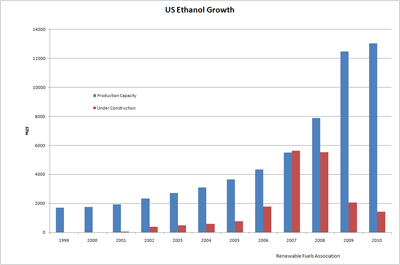Renewable fuels update
A LOOK AT THE PAST AND UPCOMING YEAR IN THE ETHANOL AND BIODIESEL INDUSTRIES
2010 WAS AN eventful year for the renewable fuels industry in both Canada and the United States. The ethanol and biodiesel industries spent much of the year under a cloud of uncertainty regarding the future of mandates and tax credits. Such uncertainty always makes new investment difficult. However, by the end of 2010, the regulatory landscape has become clearer. Meanwhile, commodity markets rallied strongly out of the global financial crisis, changing the economics of renewable fuel production.
MARKET CONDITIONS
Soft commodities were the big market movers in 2010 and as is usually the case, corn and gasoline prices moved in step. Ethanol margins were tight for most of the year however, plants remained in operation. The US biodiesel margins were worse off than the ethanol markets as they took a nosedive in the absence of the $1 per gallon tax credit.
Looking forward, a potentially severe corn and soybean acreage shortage in 2011 will necessitate demand rationing and lift prices. However, in these circumstances renewable fuel production can still remain profitable, provided gasoline and diesel prices keep up with grain commodities and the regulatory environment is favorable.

UNITED STATES
In 2010, renewable fuel subsidies were the subject of much debate in US politics. Opponents cited the need to cut government spending while proponents pressed the need to support and generate jobs. In mid-December the ethanol and biodiesel industries and the growers who supply them, received the news they wanted.
Ethanol producers received a one-year extension on their 45 cent per gallon tax credit (expected to cost US $6 billion). Congress also extended a tariff on foreign-made ethanol. The $1 per gallon US biodiesel subsidy was retroactively
re-enacted. This was an exceptional result for the biodiesel producers many of whose plants have been idle since the tax credit expired at the end of 2009.
Although the ethanol news instantly boosted corn prices, some analysts see the decision as having minimal impact on overall corn use, as blending margins remain positive and the mandated use requirements continue to spur production. The biodiesel decision will have a greater impact, as production was running at just eight percent of capacity and well below the mandated levels.
CANADA
2010 was a landmark year for Canada’s renewable fuel industry. On December 15th, the first of two national Renewable Fuels Standards (RFS) came into force in Canada. Specifically, the five percent renewable fuels standard for Canada’s gasoline pool that will ensure a market for some two billion litres of ethanol annually, making Canada the 5th largest ethanol market in the world.
Speaking at the recent Canadian Renewable Fuels Summit, Gordon Quaiattini, President of the Canadian Renewable Fuels Association described the introduction of the RFS as “truly a milestone accomplishment in the history of Canada’s renewable fuels industry” and thanked the government for keeping its word on this commitment. However, Quaiattini also warned his industry colleagues that the job was far from over.
“There is, of course, one great remaining job of work that requires urgent attention. That concerns biodiesel and the need to get the two percent renewable diesel mandate passed into regulatory effect as we have already for ethanol,” said Quaiattini.
“After years of proving our case, we note that not one large-scale commercial biodiesel plant has been built in Canada yet. That is a record we must correct in 2011.”
Quaiattini also had this to say to critics of biodiesel; “you will search far and wide to find an industry that has been subjected to greater tests or more scrutiny than biodiesel. From pilot projects to dedicated studies, from inquiries to examinations, we’ve taken on every test – and we’ve passed with flying colors.”
| Ethanol | Biodiesel | |
| Ontario | 5% | N/A |
| Manitoba | 8.5% | 2% |
| Saskatchewan | 7.5% | N/A |
| Alberta | 5% (in April 2011) | 2% (in April 2011) |
| British Columbia | 5% | 3% (5% in 2012) |
After an uncertain year in 2010, the renewable fuels industry is now in a position to attract new investment and continue growing in 2011. Acreage shortages in corn and soybeans will likely lead to some demand rationing, however, the re-instatement of tax credits in the US and the introduction of the Renewable Fuels Standards in Canada should keep profit margins in the black and plants in operation. •







